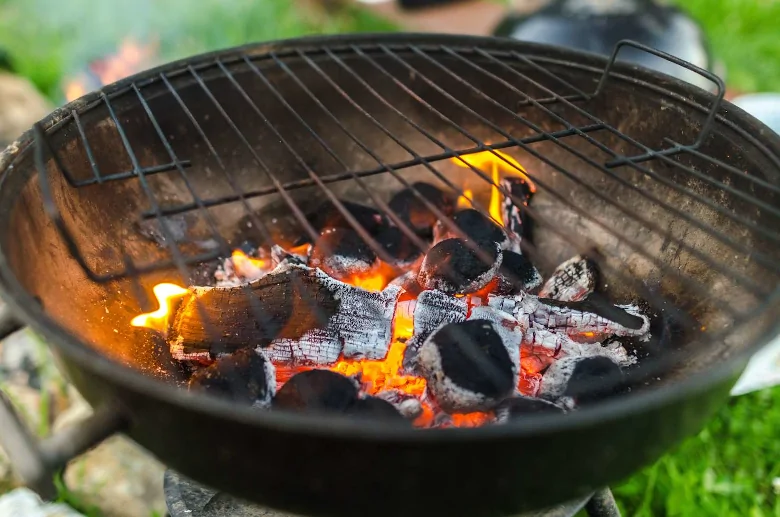Pressure
In this article, we are going to learn about Pressure. We will learn the formula of calculating pressure. We will also study about pressure in liquids and also derive the formula for calculating the pressure in liquids.
Introducing Pressure
Definition:
Pressure is the force applied perpendicular to the surface of an object per unit area. In short Pressure is defined as the force acting per unit area.
Formula:
\(\displaystyle{p =\frac {\;F\;}{\;A\;}}\)
Where \(p\) is the pressure in Pascal ( \(\text{Pa}\) ) Or Newton per square metre ( \(\text{Nm}^{-2}\) );
\(F\) is the force applied in Newton ( \(\text{N}\) );
\(A\) is the area in contact in square metre ( \(\text{m}^2\) ).
Is pressure a scalar or a vector?
Pressure is a scalar quantity. It only has magnitude but no direction.
Why study pressure?
Pressure is used when comparing the effect of forces acting on a surface.
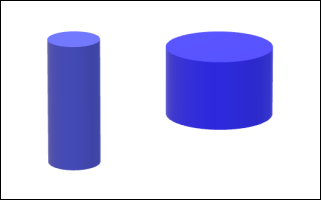
The two cylinders in the image have the same weight but different base areas.
When we put these two cylinders on a hard surface like a table, they will exert the same force on the table.
But since the base area is different, the pressure exerted by the two cylinders will be different.
What would happen if these two cylinders are put on soft muddy ground?

We see that the thinner cylinder will sink deeper into the mud but the broader cylinder will not go that deep into the mud.
Why is it so?
We know that the formula for pressure is:
\(\displaystyle{p =\frac {\;F\;}{\;A\;}}\)
Since the weight of both cylinders is the same, they will exert the same \(F\) (force) on the mud. Hence, the value of \(F\) will be the same.
The base area \(A\) is different in both cases. From the above equation, we know that the pressure applied by the object is inversely proportional to the contact area.
Thus, the thinner cylinder has a lesser contact area and thus applies more pressure on the soft mud. Hence, it sinks much deeper into the mud. The cylinder having a broader contact area applies lesser pressure on the soft mud. Thus, it sinks less.
Pressure allows us to know whether a surface is able to take the load placed on it.
Practice Questions
Question 1:
Determine the contact area of a book resting on a table, if the weight of the book is 8.00 N and the pressure exerted on the table by the book is 50.0 Pa.
- 6.25 cm2
- 160 cm2
- 400 cm2
- 1600 cm2
Solution:
Option D is the correct answer
Explanation:
By using,
\(\begin{align} p &= \frac {F}{A}\\[2ex] 50.0 &= \frac {8.00}{A}\\[2ex] A &= \frac{8}{50}\\[2ex] &= 0.16 \text{ m}^2 \end{align}\)
Because,
\(\begin{align} 1 \text{ m}^2 &= 10^4 \text{ cm}^2 \\[2ex] 0.16 \text{ m}^2 &= 0.16 \times 10^4 \\[2ex] &= 1600 \text{ cm}^2 \end{align}\)
Question 2:
A woman has a weight of 520 N. She steps on her enemy’s foot with the left heel of her stiletto heels using her entire body weight. Given that the area of the heel is 1 cm², what is the pressure exerted on her enemy’s leg?
- 260 kPa
- 520 kPa
- 2.6 MPa
- 5.2 MPa
Solution:
Option D is the correct answer
Explanation:
By using,
\(\displaystyle{p =\frac {\;F\;}{\;A\;}}\)
And
\(\begin{align} 1 \text{ m}^2 &= 10^{-4}\text{ cm}^2\\[2ex] p &= \frac{520}{10^{-4}}\\[2ex] &= 5.2 \text{ M Pa} \end{align}\)
Question 3:
A block of metal of dimensions \(0.2 \text{ m} × 0.3 \text{ m} × 0.4 \text{ m}\) rests on the floor as shown in the figure below.
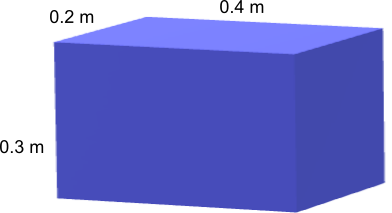
If the mass of the block is \(120 \text{ kg}\), what is the highest pressure that the block can exert on the floor?
- 2000 Nm-2
- 10000 Nm-2
- 20000 Nm-2
- 40000 Nm-2
Solution:
Option C is the correct answer
Explanation:
\(\displaystyle{p =\frac {\;F\;}{\;A\;}}\)
And,
\(\begin{align} F &= W \\[2ex] &= mg\\[2ex] &= 120 × 10 \\[2ex] &= 1200 \text{ N} \end{align}\)
We want to find the highest pressure. Hence, the area has to be the smallest. Thus, we choose the two shortest sides of the box.
\(\begin{align} p &= \frac {\;1200\;}{\;0.2\; \times \;0.3\;}\\[2ex] &= 20\, 000 \text{ Nm}^2 \end{align}\)
Question 4:
A cement mixer is placed on a large flat board to prevent it from sinking into soft ground.
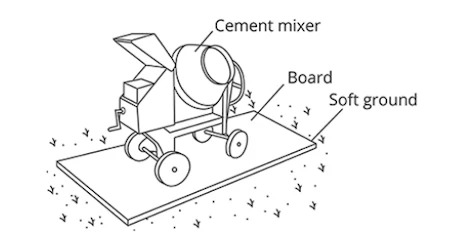
How does the board prevent the mixer from sinking?
- The increased area decreases the pressure on the ground.
- The increased area increases the pressure on the ground.
- The large area decreases the weight on the ground.
- The large area increases the weight on the ground.
Solution:
Option A is the correct answer
Explanation:
As the area of the surface increases, and the weight of the cement mixer remains the same, the pressure on the ground decreases.
Question 5:
A dune buggy has a sail of area \(6 \text{ m}^2\). Wind blowing the sail creates an excess pressure of \(5 \times 10^2 \text{ Pa}\) on it.
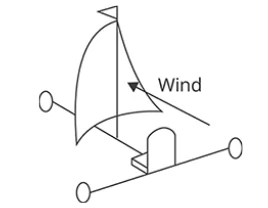
What is the acceleration of the buggy, in \(\text{ms}^{-2}\), if the mass of the buggy including the driver measures to be \(120 \text{ kg}\)?
- 2.5
- 5.0
- 25
- 50
Solution:
Option C is the correct answer
Explanation:
By using,
\(\begin{align} p &= \frac {\;F\;}{\;A\;}\\[2ex] \frac {\;F\;}{\;6\;} &= 5 × 10^2\\[2ex] F &= 5 \times 10^2 \times 6\\[2ex] &= 3000 N\\[2ex] \end{align}\)
Now,
\(F = m \times a\)
Where,
\(m = 120 \text{ kg}\)
So,
\(\begin{align} 3000 &= 120 \times a \\[2ex] a &= 3000 \div 120\\[2ex] &= 25 \text{ ms}^{-2}\\[2ex] \end{align}\)
Pressure In Liquids
Pressure in liquids refers to the force exerted by a liquid per unit area on the surface with which it is in contact. It arises due to the weight of the liquid above the surface and is transmitted equally in all directions (Pascal's Principle).
Below is a rectangular tank completely filled with a liquid of density. The tank has a base area of \(A\) and height \(h\).
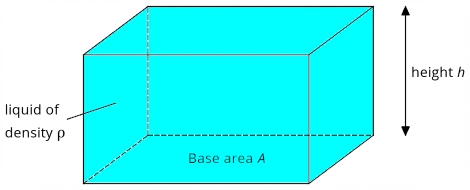
Volume of liquid in the tank \(V = A h \)
Mass of the liquid \(m = ρ V\)
Weight of the liquid \(W = m g\)
Substituting the value of \(m\)
\(W = (ρV) g\)
Substituting the value of \(V\)
\(W = ρ (A h) g\)
Pressure p at the bottom of the tank \(\displaystyle{=\frac {\;F\;}{\;A\;}}\)
\(F\) is actually the weight of the liquid \(W\). Substituting \(W\) in the equation.
Pressure p at the bottom of the tank
\(\displaystyle{= \frac {\;W\;}{\;A\;}}\)
\(\displaystyle{=\frac {\;ρ (A h) g\;}{\;A\;}}\)
\(= ρ g h\)
Pressure p at the bottom of the tank \(= ρ g h\)
What does the formula (\(p = ρ g h\)) imply about pressure in liquids?
The diagram below shows a water tank with holes at three different heights. Water at the bottom hole is observed to move the furthest distance.
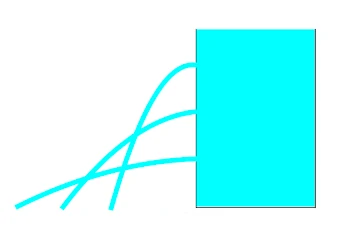
From the above diagram, we observe that as we go deeper down in the tank, the weight of the liquid above us increases and thus the pressure acting on us increases.
The larger the height (or depth), \(h\), of the liquid, the larger the liquid pressure.
Let us consider another situation.
We have two containers of the same height but different base areas filled with similar liquids. We poke a hole in the two containers at the same height.
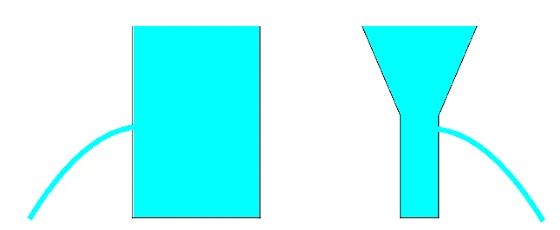
We can see from the above diagram that the water spurts out from the two containers at the same horizontal distance from the base of the container.
Similar liquids of the same height (depth) exert the same pressure, regardless of base area.
\(p = ρ g h\)
The pressure of the liquid is independent of the base area of the container.
Question 6:
An oil barrel of height 1.50 m, radius 55 cm is filled with oil of density 932 kg m⁻³. What is the pressure, due to the oil alone, on the base of the tank? (Take g to be 10 N kg⁻¹.)
- 9810 Pa
- 13300 Pa
- 14000 Pa
- 513000 Pa
Solution:
Option C is the correct answer
Explanation:
By using,
\(\begin{align} p &= ρ g h\\[2ex] p &= 932 \times 10 \times 1.5 \\[2ex] &= 13980 \text{ Pa} \\[2ex] &≈ 14000 \text{ Pa (rounded off)} \end{align}\)
Question 7:
Arrange the positions in the container in order of increasing pressure.
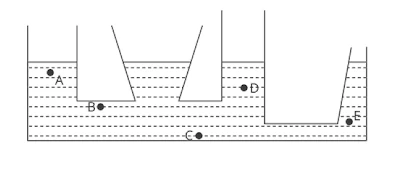
- A, D, B, E, C
- A, B, D, C, E
- B, A, D, C, E
- A, D, E, B, C
Solution:
Option A is the correct answer
Explanation:
The larger the depth, the larger the amount of liquid above and thus the larger is the pressure.
Question 8:
Liquid X has a density of 1010 kg m⁻³. Liquid Y has a density of 950 kg m⁻³. The liquids are poured into tubes as shown.
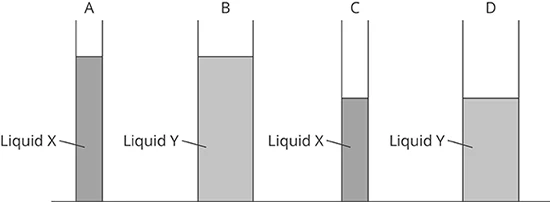
Which tube exerts the least pressure on its base?
- A
- B
- C
- D
Solution:
Option D is the correct answer
Explanation:
By using,
\(p = ρ g h\)
From this formula, we can see that p is directly proportional to the density of the liquid. Thus, higher the density of the liquid, the higher the pressure.
The greater the depth of the liquid in the tube, the greater the pressure exerted at the base of the tube. The pressure of liquid is independent of the base area. Thus, the cross-sectional area of the tube does not matter.
Comparing tubes B and D, we observe that the height of the liquid in tube D is lower. Thus, it will exert less pressure on the base.
Question 9:
Water of density 1000 kg m⁻³ fills up to 30 cm in a container. The base of the container is broken accidentally and water starts to leak from a tiny hole area of 1.0 mm². To prevent water from leaking, a sticky tape is used to cover the tiny hole. Determine the minimum force that the tape must be able to withstand.
- 0.003 N
- 0.3 N
- 30 N
- 3000 N
Solution:
Option A is the correct answer
Explanation:
Here,
\(\begin{align} ρ &= 1000 \text{ kg m}^{-3}\\[2ex] h &= 30 \text{ cm}\\[2ex] &= 0.3 \text{ m}\\[2ex] g &= 10 \text{ N kg}^{-1} \end{align}\)
By using,
\(\begin{align} p &= ρ g h\\[2ex] &= 1000 × 10 × 0.3 \\[2ex] &= 3000 \text{ Pa} \end{align}\)
Also,
\(\displaystyle{\text{Pressure}} = \frac {\text{Force}}{\text{Area}}\)
So,
Force = Pressure × Area
Where,
Area of the hole = 1.0 mm²
Because,
1 mm² = 10⁻⁶ m²
Therefore,
Force = 3000 × 10⁻⁶
= 0.003 N
The tape must be able to withstand the force of 0.003 N
Conclusion
In this article, we learnt about the Introduction to Pressure and Pressure in liquids as per the Secondary 3 Physics syllabus.


 SG
SG  VN
VN 


